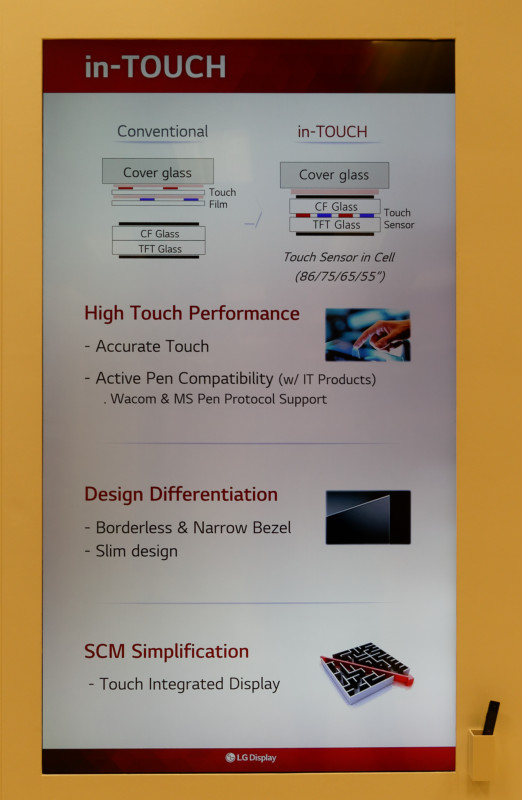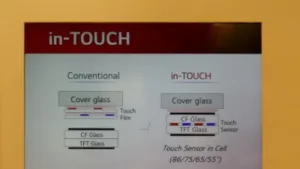Last week, I covered one of the panel trends that I saw at last week’s CES show (If One LCD is Not Enough, Try Two) and on Monday, Sweta covered a number of the display stories (OLED, QLED, MicroLED and LCD at CES 2019 – Bigger & Better). But today I want to talk about what appeared to me to be a significant breakthrough in large panels.

Increasingly users expect displays to be interactive. The ‘training’ that youngsters get on tablets and smartphones, from an early age, leads them to assume that large screens are also touch enabled. However, the path to making large interactive displays has been a tough one. By and large, big monitor makers take an off-the-shelf panel and add a touch panel to add interactivity. Large panels were difficult to enable with the touch technology that most people prefer, and that is used in smartphones and tablets and that is projected capacitive (PCap) touch.
I wrote a booklet around 20 years ago on different touch technologies and at that time, PCap was a niche touch technology that was just used in unusual situations. Most touch was based on resistive technology (which ruined the visual performance) or direct capacitive or sound technology. All of these had disadvantages.
When Apple introduced the iPhone, it made a decision to use a PCap touch system. At the time, I heard, the PCap technology cost more than the LCD that it was built on, so it was a high risk strategy for Apple, but PCap was the technology that could deliver the kind of image quality and responsiveness that Apple wanted on the device. At that time, accurate PCap was limited to small devices, but over the years, the maximum size of PCap touch panels has increased, but the technology is still relatively expensive.
As a result of the high cost of PCap on large displays, infrared has been widely used, but the experience of using infrared really hasn’t met the requirements of corporate users for a great experience. Brands have told me in the past that potential buyers of large numbers of interactive meeting room displays would get one infrared-based system, but after evaluating, would not proceed to significant roll-outs as the responsiveness and performance were simply not good enough.
Companies such as Sharp and Microsoft have developed large capacitive displays, but with relatively high costs, which has limited the market.
One of the downsides of adding a PCap touch panel is that adding another panel can reduce image quality because of the extra glass/air interfaces. An air gap also means that the stylus of pen operation is not as accurate or as intuitive as it might be, in an ideal world. One solution is to bond the touch panel to the LCD using an adhesive that has the same refractive index as the glass so that the number or interfaces drops and allows the panels to be very close, without problems such as ‘Newton’s Rings’ which can come from putting the panel too close with an air gap.
However, the reality of what seems to be a simple process of optically bonding is that it is often a tricky process to optimise and ensure high yield. A low yield rate can be very expensive. It has been widely rumoured that the challenges with optical bonding were the reason for the delay Microsoft had in shipping its impressive Surface Hub display. Microsoft insisted on using bonding to ensure that there was as little parallax error as possible between the display and pens being used. Bonding also means better contrast.
At CES, I had the privilege of getting a guided tour around the LG Display suite, where it was showing its latest panels. There were rollable OLEDs, 8K OLEDs, a transparent OLED and a second one with a black background to solve problems of showing video content on transparent OLEDs (the black is just clear in this case).
My eye was caught, though, was of a 65″ LCD panel with ‘in cell touch’ (55″, 75″ and 86″ have also been developed). It was being shown with a panel with an air gap and another with a bonded panel. Staff told us that the air-based unit should cost about the same as an infrared solution. The company understood that the image quality can be made very good and performance should also be high (10 touches are supported). What LG hadn’t fully understood, until we explained it, was the big issue that it has solved in terms of the parallax error.

Now, having the panel on its own is not enough. The panel needs to work with a controller, but LG Display told us that it has worked with controller makers. Despite that comment, we talked to Synaptics, which makes touch controllers, and the staff at CES didn’t seem to know about the development.
We didn’t get more information about availability, but if I was developing large interactive monitors, I would be in contact with LG Display immediately to try to find out how quickly I could get a product designed and into the market! BR

